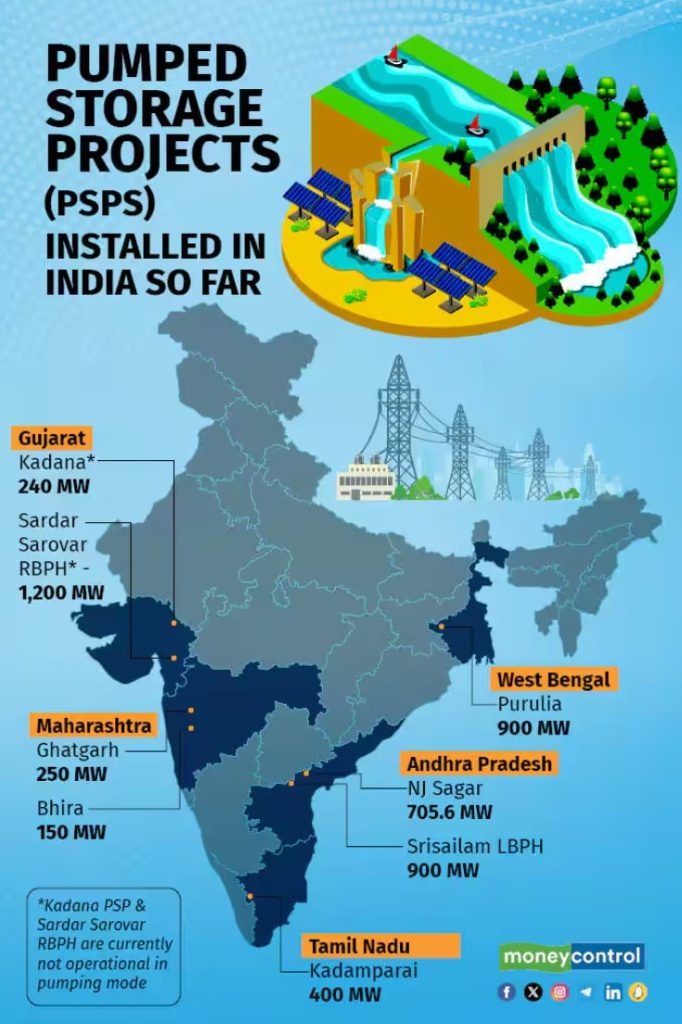CONTENTS
- The Relevance of Pumped Storage Projects
- The Supreme Court’s Decision in Allowing GM Mustard
The Relevance of Pumped Storage Projects
Context:
The Union Budget for 2024-25 promised a new policy to promote pumped storage projects for electricity storage, aiming to smoothly integrate the increasing share of renewable energy, which is inherently variable and intermittent.
Relevance:
GS3- Environmental Pollution and Degradation, Infrastructure- Energy
Mains Question:
Discuss the principle of operation of pumped storage projects highlighting their significance. Where are some of the pumped storage projects of India situated and what challenges do such projects face in general? (15 Marks, 250 Words).
Pumped Storage Project (PSP):

- A Pumped Storage Project (PSP) is a hydroelectric power system designed for large-scale energy storage.
- It operates by pumping water from a lower reservoir to an upper reservoir when energy demand is low and then releasing it back through turbines to produce electricity during times of high demand.
Types of Pumped Storage:
- There are two types of pumped storage: on-river and off-river. On-river projects resemble typical hydroelectric projects fed by a river.
- Off-river projects involve two reservoirs at different levels, where water is pumped up or allowed to flow down under gravity in a closed loop.
- When there is excess power, water is pumped from the lower reservoir to the upper one, and when power is needed, the water flows down to drive turbines and generate electricity. An example of such a project is in Kadamparai, Tamil Nadu.
Why is Pumped Storage Important?
- India has set an ambitious goal to generate 500 GW of non-fossil fuel energy by 2030. Between 2021 and 2023, it added about 23 GW of non-fossil generation capacity.
- Of the total 10 GW added in the first eight months of 2023-24, 7.5 GW came from wind and solar energy, highlighting that renewables will constitute most of India’s new power generation.
- While the share of renewable power generation will increase, this energy will be variable and unreliable.
- Indian policies mandate that all renewable energy generated should be utilized, with curtailment as a last resort.
- Advanced forecasting techniques have improved the accuracy of predictions regarding daily variations in renewable power generation.
- This enables grid operators to plan how to adjust power generation from other sources to maintain a steady supply for consumers.
- For instance, hydroelectric power can be quickly adjusted within seconds, whereas coal and nuclear energy require hours of notice.
- As global attention shifted to renewables and their variable power generation issues, several solutions for energy storage and release were proposed for times when wind and solar power are low.
- Previously, large-scale electricity storage was nonexistent. Proposed methods include scaling up batteries and using compressed air in large caverns for power generation when needed.
- However, most of the world’s energy storage now relies on pumped storage using water, which functions like massive natural batteries.
Does India have Pumped Storage?
- India currently has 3.3 GW of pumped storage, with major facilities in Nagarjunasagar, Kadana, Kadamparai, Panchet, and Bhira.
- China leads with 50 GW of pumped storage supporting 1,300 GW of wind and solar energy.
- India must significantly increase its pumped storage capacity to meet its renewable energy targets.
How does the Pumped Storage at Kadamparai Operate?
- The Kadamparai plant, located in the Coimbatore district and established around 37 years ago, has four units, each with a capacity of 100 MW.
- The plant features an upper reservoir situated approximately 380 meters above a lower reservoir.
- Each unit has a turbine generator set that produces power when water flows from the upper reservoir to the lower one.
- The same unit can also function as a pump, using power to transfer water from the lower reservoir to the higher one.
- Power managers plan in advance for the next day, considering expected demand and wind and sunshine forecasts to determine the operation schedule for each power plant in the state.
- Typically, there is a power surplus around noon from solar energy, which is used to pump water at Kadamparai.
- Each unit requires 20% more power to operate as a pump than it can produce as a generator, but since solar energy is used, no fuel is burned to generate the necessary power.
- When the Kadamparai plant operates as a pump to store energy, it takes about an hour and a half to switch to generating mode.
- When stopped, it requires about half an hour to start and generate at full capacity.
- After solar generation ends and the evening peak load begins post-6 pm, the Kadamparai plant switches to generator mode.
- It can produce 400 MW of full power for three to four hours to support evening peak loads.
Conclusion:
PSH provides economic benefits, including job creation and local economic growth, while also enhancing grid stability. It acts as a reliable energy storage solution, helping balance the grid during periods of high demand or low supply. While Pumped Storage Hydropower (PSH) offers many advantages, it faces challenges such as geographical limitations and high capital costs. However, ongoing research and innovation are expected to address these issues, leading to increased efficiency and capacity.
The Supreme Court’s Decision in Allowing GM Mustard
Context:
India’s challenging journey with genetically modified (GM) food crops reached another milestone last week. A two-judge Bench of Justices B.V. Nagarathna and Sanjay Karol from the Supreme Court of India delivered a split decision on whether to allow GM mustard in farmers’ fields.
Relevance:
GS3- Biotechnology
Mains Question:
GM crops might not be perfect, but what matters is that they are useful. Discuss this in the context of the ongoing discussions about GM Mustard. (10 Marks, 150 Words).
Current Status of GM Crops:
- Currently, the only GM seed permitted in India is cotton. The increase in cotton yield encouraged both private and public agricultural institutions to develop GM seeds for food crops like rice, wheat, tomato, brinjal, and mustard, though none have been released yet.
- This is central to the story of DMH-11, or Dhara Mustard Hybrid-11, developed under a publicly funded project at Delhi University’s biotechnology department.
- The genes in this plant make it attractive to private seed companies for creating new hybrid varieties.
What is GM Mustard?

- Dhara Mustard Hybrid-11 (DMH-11) is a transgenic mustard developed indigenously.
- It is a genetically modified variant of Herbicide Tolerant (HT) mustard, resulting from a cross between the Indian mustard variety ‘Varuna’ and the East European ‘Early Heera-2’ mustard.
- It contains two foreign genes (‘barnase’ and ‘barstar’) derived from a soil bacterium called Bacillus amyloliquefaciens, enabling the breeding of high-yielding commercial mustard hybrids.
- DMH-11 has demonstrated approximately 28% higher yield than the national average and 37% more than regional averages. Its use has been endorsed and approved by the GEAC.
- The “bar gene” ensures the genetic purity of the hybrid seed.
Approval of DMH-11:
- For crops to be approved in India’s agricultural system, they must be tested over three seasons in various agro-climatic zones and prove consistently superior to existing varieties.
- Trials over three years by the Indian Council of Agricultural Research indicated that DMH-11 met these criteria.
- This led the Genetic Engineering Appraisal Committee (GEAC), a scientific advisory body under the Ministry of Environment and Forests, to approve DMH-11 in October 2022, subject to certain tests.
- However, environmental groups claim that DMH-11 is a ‘herbicide-tolerant’ crop, genetically engineered to compel farmers to use specific pesticides, with harmful environmental effects.
- They allege that the developers were not transparent about this information.
- These findings, along with the GEAC approval, have been challenged in court by Aruna Rodrigues and the organization Gene Campaign.
Ruling of the Supreme Court:
- The judges had differing opinions on whether the GEAC’s actions were appropriate. Justice Nagarathna argued that the GEAC had violated the “precautionary principle,” which dictates that any new organism or technology should be restricted unless its consequences are thoroughly considered.
- Justice Karol, on the other hand, appeared satisfied with the GEAC’s process. As a result, the case has been referred to a larger Bench led by the Chief Justice of India.
- A significant outcome was the Court’s directive to the Centre to develop a policy on GM crops.
- The debate over GM crops is primarily ideological rather than based on traditional agricultural measures like yield and farm economics.
- This is highlighted by India’s agricultural history, where past solutions like hybrid seeds and synthetic fertilizers, while boosting yields and productivity, have also caused environmental damage.
Conclusion:
In their decisions, both the Court and the government should remember that pursuing the good should not be seen as opposing the perfect.



